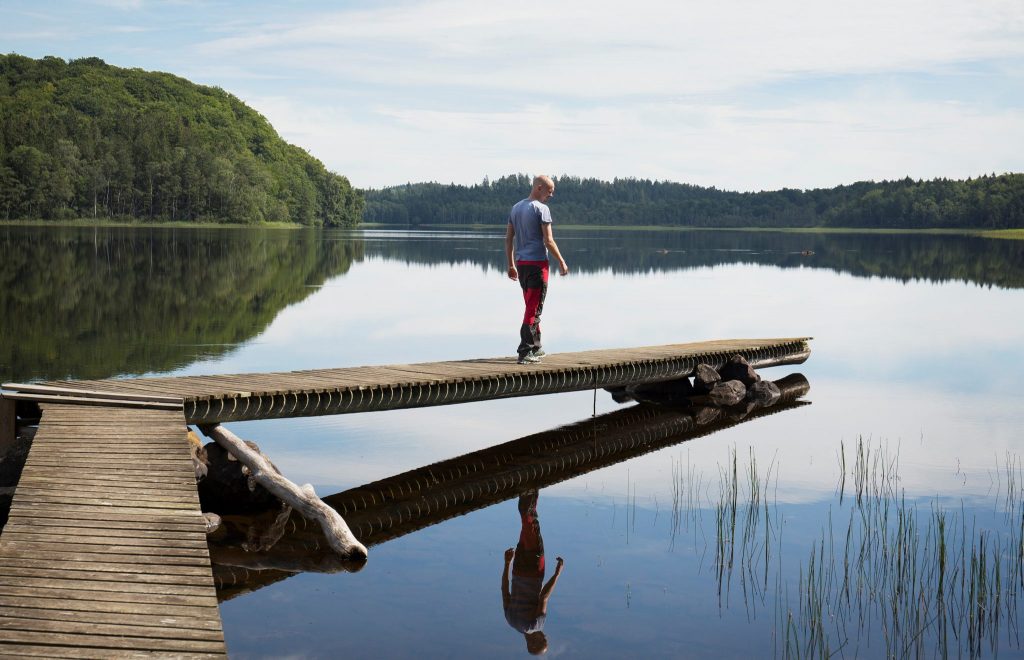Route
The route is presented on https://www.svenskaturistforeningen.se/guider-tips/leder/europaled-1/ (only in swedish right now, but soon an english version will be available). There you can also learn about how it is to walk in Sweden https://www.swedishtouristassociation.com/hiking/
The route E1 is described from south to north. Most of it is in lowland, but in the north in mountains (in Swedish “fjäll”).

Starting Point
Halmstad – town
The StenaLine ferry between Grenå and Halmstad operates only once per day and does not accommodate foot passengers due to traffic issues at the Halmstad harbour.
Therefore, ERA recommends the following alternative route:
– In Denmark, continue along Hærvejen to or from Frederikshavn. Hærvejen extends from Padborg to Frederikshavn. You can find more information about Hærvejen here.
– Take the StenaLine ferry between Frederikshavn and Göteborg. This ferry operates several times per day and accepts foot passengers.
– In Sweden, connect to or from E1 in Göteborg. You can use WaymarkedTrails to navigate within Göteborg.
This route ensures a smoother and more accessible journey for foot passengers.
End Point
Grövelsjön – village in the mountains with STF mountain station
Which cities and towns does the E-path pass through
Passes close to the city of Göteborg (Gothenburg) and a number of small towns and municipalities: Borås, Ulricehamn, Karlsborg, Lindesberg, Smedjebacken, Leksand, Mora, Sälen.
Length
About 1200 km
Ground paths of the E-path
Halmstad – Simlångsdalen , local path, 18 km
Simlångsdalen – Blåvettnerna, path Hallandsleden, 200 km, www.hallandsleden.se
Blåvettnerna – Skatås (Göteborg), path Bohusleden,27 km, www.bohusleden.se
Skatås (Göteborg) – Hindås, path Vildmarksleden, 38 km,
Hindås – Mullsjö, path Sjuhäradsleden, https://www.vastsverige.com/en/ulricehamn/leder/the-sjuharad-trail/ and https://naturkartan.se/en/sjuharadsleden
Mullsjö – Karlsborg, path Västra Vätterleden, 189 km, www.skaraborgsleder.se
Karlsborg – Kloten, path Bergslagsleden, 280 km, www.bergslagsleden.se
Kloten – Björsjö, path Malingsbo-Klotenrundan, 20 km, www.visitdalarna.se
Björsjö – Jätturn, path Sméleden, 57 km, www.smedjebacken.se
Jätturn – Leksand, mostly paths Gagnefs fäbodstigar, 80 km, limited information
Leksand – Mora, path Siljansleden, 70 km, https://www.swedishtouristassociation.com/trails/siljansleden/
Mora – Sälen, path Vasaloppsleden, 90 km, https://www.svenskaturistforeningen.se/guider-tips/leder/vasaloppsleden/
Sälen – Grövelsjön, local paths, 160 km, www.malung-salen.se and https://issuu.com/adpine/docs/mst-vandringsfolder_2019_issuu
Responsible organisations
Regional and local organizations and municipalities. Information about which are the responsible organisations you find in the respective links to the footpaths.
Publications
There is no publication for E1 in Sweden as a whole. See the respective links where information in terms of descriptions and maps and reference to leaflets and maps can be found. Note that some of the routes only have information in Swedish.
Maps
See the respective links for information about maps. For smaller footpaths maps can be found on www.naturkartan.se/en/
Marking system
Marking systems differ even if most of them have orange bands around trees and poles. In addition some of footpaths, but not all, have the E1-mark (blue with 15 yellow stars) in addition. Where E1 switches between two regional footpaths there can be stretches with no marked trail.
Crossing other E-paths
E1 and E6 use a short common part of Hallandsleden

Practical
Accommodation
STF youth hostels are available for some parts of the E-path. Several links also have information about other kinds of accommodation like bed-and-breakfast, hotels. There are also shelters on some of the foot-paths. You are allowed to use you own tent in many places.
Food
Food can be bought in stores in villages, municipalities and towns close to the footpaths. For some parts you will have to carry food with you for a couple of days. Water can have to be carried with you for a day.
Travel
There is an extensive network of buses and trains close to the footpaths.
Gear
No special equipment is needed. Good shoes that can stand also wet ground and rain-gear is recommended.
Ingemund 8 juli 2020


 Eurorando 2026 – Europe’s biggest hiking event!
Eurorando 2026 – Europe’s biggest hiking event! 
 20–27 September 2026
20–27 September 2026 Ore Mountains (Erzgebirge), Germany–Czechia
Ore Mountains (Erzgebirge), Germany–Czechia 50+ guided hikes
50+ guided hikes



